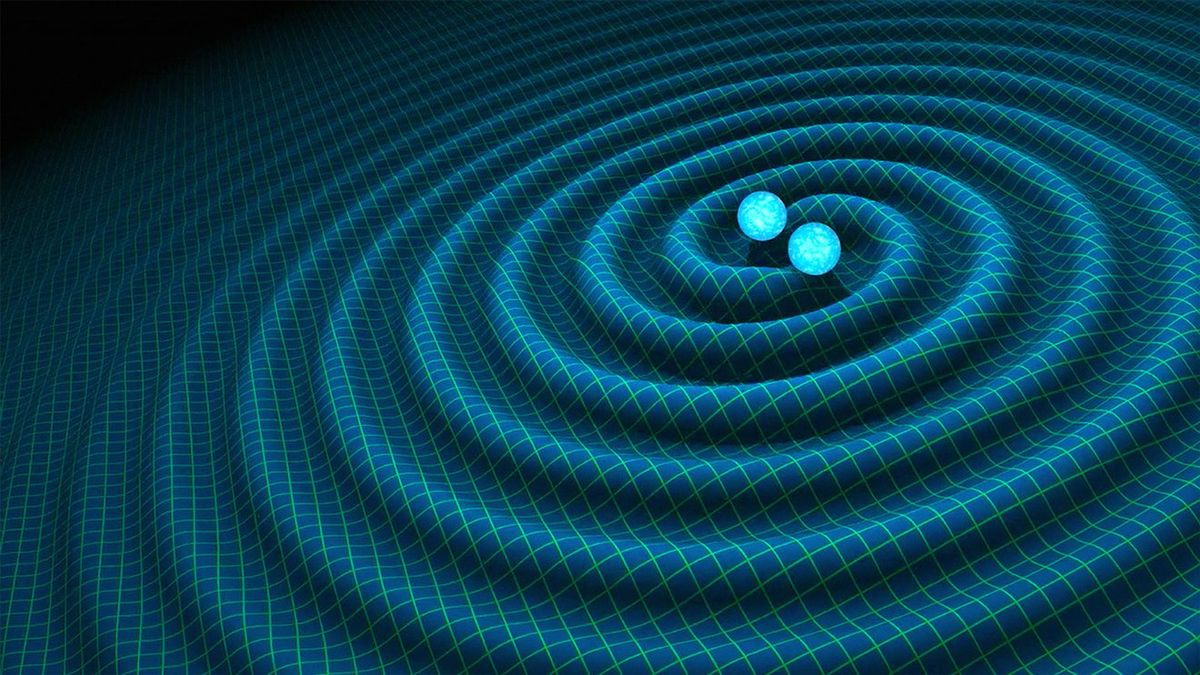
Paul M. Sutter is an astrophysicist at SUNY Stony Brook and the Flatiron Institute, host of "Ask a Spaceman" and "Space Radio," and author of "How to Die in Space." Sutter contributed this article to Space.com's Expert Voices: Op-Ed & Insights.
Gravity isn't just a force that keeps things glued together. Through our understanding of general relativity, we know that gravity can make gravitational waves, or ripples in the fabric of space-time.
But how do these gravitational waves work, exactly?
Shortly after formulating his general theory of relativity, Albert Einstein realized that gravity can make waves. However, he quickly doubted his own conclusions. The realization that gravitational waves exist came from a simplified form of general relativity, and Einstein didn't know if the waves were real or just an artifact of the simplification process.
Related: We could hunt gravitational waves on the moon if this wild idea takes off
The equations of general relativity are notoriously difficult to solve, so it's no surprise that even Einstein equivocated about this. It took several decades before physicists came to the firm conclusion that general relativity does support gravitational waves. In other words, they are indeed a real thing.
Pretty much anything in the universe doing anything at all makes gravitational waves. All it takes is a little wiggling, which gravitational waves have in common with pretty much any other wave. If you wiggle around in water, you make water waves. If your voice box wiggles around, it makes sound waves. If you wiggle an electron, you make electromagnetic waves. To make a gravitational wave, all you need to do is make mass accelerate.
These waves travel outward from the source at the speed of light and are literal ripples in the force of gravity. When a gravitational wave passes through you, you get stretched and squeezed as if giant hands were playing with you like a piece of putty.
Did you feel that?
Even though pretty much everything in the universe is making gravitational waves all the time, you don't really notice them. Gravity is, by far, the weakest of the four fundamental forces of nature. Even if gravity were a billion billion billion times stronger than it is, it would still be orders of magnitude weaker than any of the other forces: the weak force, electromagnetism and the strong force. And gravitational waves are weaker still; they are tiny perturbations on top of the normal gravity.
This also means that the gravitational waves that you might make by, say, waving your arms around are almost entirely nonexistent. To make a serious dent in space-time, you need some serious mass and energy action — stuff like black hole collisions, neutron star smashups, supernovas, giant black holes that consume stars whole or even the chaotic forces unleashed in the earliest moments of the Big Bang.
If you were within about half a mile of two black holes merging, the gravitational waves emitted would be strong enough to tear you apart. But if you were hundreds of miles away, it wouldn't even make the hair on the back of your neck stand on end.
From our vantage point on Earth, millions or billions of light-years away from these cataclysmic events, the gravitational waves have an amplitude no bigger than the width of a proton.
Of course it was weird
The extreme weakness of gravitational waves is why it took nearly a quarter century of technological development to detect them. But in 2015, the Laser Interferometer Gravitational-Wave Observatory (LIGO) confirmed the first direct detection of gravitational waves. The source of that particular signal was two black holes merging 1.4 billion light-years away.
There's an upside to the weakness of gravitational waves: Because gravity is so weak, the gravitational waves barely interact with matter, thereby allowing them to propagate freely throughout the universe without scattering or being absorbed. It also means we can see things we normally couldn't.
If two black holes collide in the middle of space, how could we really see them? If they don't emit any form of electromagnetic radiation during the collision, the entire process is invisible to our telescopes. But those collisions release tremendous amounts of energy in the form of gravitational waves — usually more power than that produced by all of the stars in the universe combined.
Since that first confirmed detection in 2015, LIGO and Virgo — its sibling observatory in Italy — have confirmed over four dozen black hole collisions. We've gone from the occasional gravitational wave detection to a full-fledged branch of astronomy. These subtle vibrations have unlocked insight into the inner workings of the cosmos and newfound mysteries for the next generation of astronomers.
Learn more by listening to the episode "What's so groovy about gravitational waves? (Part 1)" on the "Ask a Spaceman" podcast, available on iTunes and askaspaceman.com. Ask your own question on Twitter using #AskASpaceman or by following Paul @PaulMattSutter and facebook.com/PaulMattSutter.
Follow us on Twitter @Spacedotcom and on Facebook.
"how" - Google News
August 23, 2021 at 06:08PM
https://ift.tt/3ybARXl
How do gravitational waves work? - Space.com
"how" - Google News
https://ift.tt/2MfXd3I
https://ift.tt/3d8uZUG
Bagikan Berita Ini














0 Response to "How do gravitational waves work? - Space.com"
Post a Comment